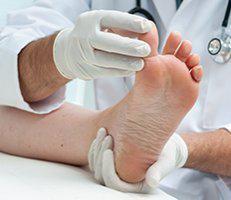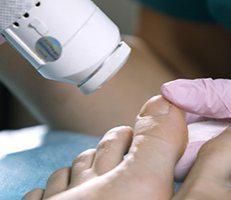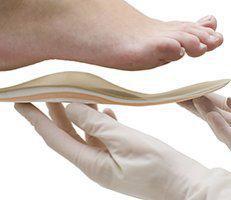What is Podiatry?

A podiatrist is a physician (also commonly known as a foot doctor) dedicated to the medical and surgical treatment of foot and ankle disorders for people of all ages and activity levels.
Training includes education in all systems of the body in order to provide a comprehensive treatment plan. Podiatrists can manage and treat foot problems which pose an ongoing threat to a patient’s health. Such conditions include diabetes, arthritis, and cardiovascular disease. Podiatrists work closely with internists and specialists involved in a patient’s overall healthcare. Foot doctors are uniquely qualified to detect warning signs in the early stages of the disease in the lower extremities.
To diagnose a foot problem, podiatrists may take x-rays and order laboratory tests. The foot may be the first area to show signs of serious conditions such as arthritis, diabetes, and heart disease. For example, diabetics are prone to foot ulcers and infections due to poor circulation and lack feeling in feet. Podiatrists consult with and refer patients to other health practitioners when they detect signs of these disorders.
Podiatrists treat corns, calluses, ingrown toenails, bunions, heel spurs, and arch problems; ankle and foot injuries, deformities, and infections; and foot complaints associated with diseases such as diabetes and gout.
To treat these foot problems — podiatrists may prescribe medication, order physical therapy, set fractures, and perform surgery. They also fit custom-made corrective inserts called orthotics.
Podiatrists need a State license that requires the completion of at least 90 hours of undergraduate study, the completion of a 4-year program at a college of podiatric medicine, and a postdoctoral residency program of at least two years.
Colleges of podiatric medicine offer a four-year program where the curriculum is similar to other schools of medicine. During the first two years, podiatry students receive classroom instruction in basic sciences, including anatomy, chemistry, pathology, and pharmacology. Third and fourth-year students have clinical rotations in private practices, hospitals, and clinics. During rotations, they learn how to take general and podiatric histories, perform routine physical examinations, interpret tests and findings, diagnose, and perform therapeutic procedures. Graduates receive the degree of Doctor of Podiatric Medicine (DPM).
Podiatrists excel in scientific aptitude, diagnostic skills, manual dexterity, interpersonal skills, and good business sense.
The journey to healthy feet begins with a single step! So put one foot in front of the other…
Contact Dr. Mancherian, foot and ankle specialist, for an appointment today.

About Dr. Mancherian
At The Foot and Ankle Wellness Clinic, in Los Angeles, California and Glendale, California, Dr. Suzanne Mancherian treats patients throughout the area and provides care for ankle and foot injuries, ingrown toenails, nail replacement, neuromas, corns and calluses, laser toenail fungus treatment, prescription orthotics and plantar fasciitis.
Dr. Mancherian obtained her Bachelor’s in Political Science at the University of California-San Diego. She then went on to graduate with a degree in Biology from the Dr. William M. Scholl College of Podiatric Medicine. Following this, she obtained her graduate degree as a Doctor of Podiatric Medicine. Her residency training was completed at the Veterans Affairs hospital in North Chicago specializing in Medicine and then at St. Joseph’s Hospital affiliated with Northwestern University also in Chicago, specializing in Surgery. She is a member of the American Podiatric Medical Association, the California Podiatric Medical Association, and the Los Angeles County Podiatric
RELIEF IS A STEP AWAY!
Given the complexity of their structures and the tremendous force loads they endure on a regular basis, it is not surprising that feet and ankles can develop an array of issues. This means there is no “catch all” treatment to fix everything. Instead, podiatrists rely on various tools and techniques to provide relief from painful symptoms and restore functionality for our patients.
One of the tools we uniquely use here at Foot and Ankle Wellness Clinic to address cushioning issues and keep your feet protected is liquid silicone implantation. Let’s take a look at this effective treatment option and the various conditions and situations where it is used.
Insurance Information
We accept most PPO insurance plans as well as Medicare.
Please call to confirm your insurance coverage.











